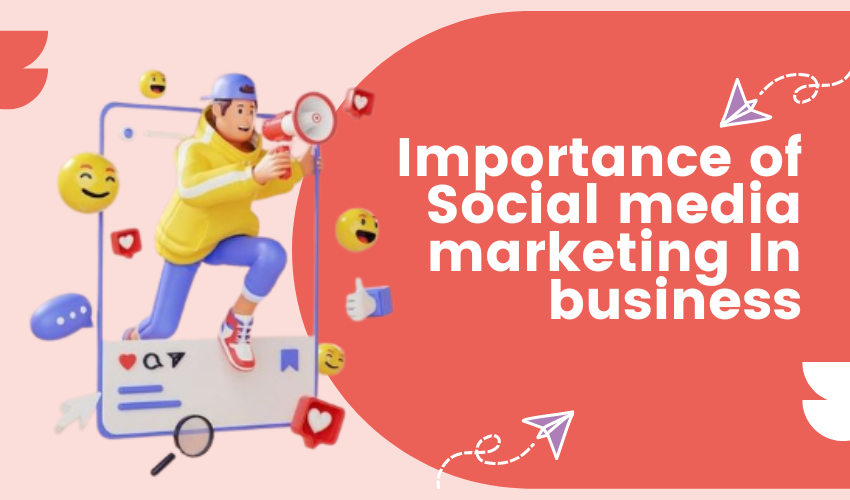Taking advantage of social media marketing is an amazing strategy that can be used to expand your business and raise awareness of the services that you provide to other people.
These days, social media is at the forefront of how you may simultaneously communicate with the greatest number of people.
In this blog, we will look more in-depth at the importance of social media marketing for your organization to reap from effective social media management.
Define Social Media Marketing:
Let’s define social media marketing to get started. Social media marketing services promote goods, services, and brands on social media to reach and engage a target audience. It entails developing and distributing excellent content, encouraging community participation, and using social media tools and analytics for marketing.
How does Social Media Marketing build brands?
Companies need a strong brand presence to compete in the digital era and stand out. Social media marketing helps firms interact with their target audience and establish brand equity. This blog will cover how social media marketing affects brand growth, essential implementation tactics, successful case studies, hurdles, and ways to quantify success and some social media marketing importance.
Explain about Brand Building:
A solid understanding of brand development is necessary before diving into the benefits of social media marketing function in establishing a brand. The brand represents the identity, values, and reputation of a firm. In addition to the firm’s logo or slogan, it encompasses the feelings, perceptions, and experiences linked with the organization’s identity. When constructing a successful brand, it is necessary to establish a unique brand identity, successfully position that identity, design appealing messaging, and provide a consistent brand experience.
Benefits of social media marketing In business:
Brand development relies on social media and some people depend on Web Marlins as a social media marketing agency since it allows companies to communicate with their target audience. Much of the importance of social media marketing comes from brand marketing.
- Social media increases brand exposure and audience reach. Creating engaging content and sharing using hashtags may enhance company exposure, which all comes in social media marketing strategy.
- Organizations may engage targeted audiences via social media. Understanding customer preferences may improve company content and communication, and it is also on the list of benefits of social media marketing.
- For long-term success, you need committed customers. Through quality content, responding to questions, and community, companies may create connections on social media. Business loyalty increases.
- Businesses may communicate their stories and value propositions on social media. Video, compelling tales, and user-generated content can humanize brands and connect with audiences.
Best Social Media Marketing Strategies:
Social media marketing is essential in 2024. Nearly 5 billion individuals use social media, and the typical user uses six to seven networks every month. Businesses can connect, engage, and convert their target audiences on social media since so many people use Instagram, Facebook, and LinkedIn every day.
Social media is growing quickly, with new applications and trends transforming the digital environment every week. Marketers and companies struggle to keep up with this fast change. We’ve listed 5 ways to build a strong social media presence.
1. Know your audience
Knowing your audience is key to a successful social media strategy. Once you know who you want to promote to, you can create exceptional content that resonates and lasts. Although trends come and go, exceptional content that aligns with your brand’s values will always resonate.
2. Pick the right platforms:
There are several platforms, making it difficult to choose one for your advertising needs. The typical individual has eight social media accounts. Distinct social channels have distinct goals.
3. Use content to attract them:
Content becomes your hidden weapon if you know your audience and the channels to reach them. Engaging material keeps readers engaged, not simply attracts them. Imagine speaking to your client. Your material was intended for them.
- Quality and involvement helps so High-quality imagery and narrative will engage viewers and motivate them to comment.
- Next, brand language and visual consistency are crucial. Trust and loyalty will increase when your audience knows your style. Stick to your tone, whether informal or professional, to establish familiarity.
4. Keep them engaged:
Successful digital marketing requires audience engagement on your company’s social media sites. After your advertising gets their attention, urge them to interact with your organic postings.
- Consider social media a virtual friend gathering. Responding to comments is like talking. Replying to compliments or questions shows you care and appreciate their opinions.
- Don’t simply comment, start discussions! Polls, questions, anything to get people talking. It helps you understand and respect them. Address concerns or problems honestly and kindly. Reversing a negative demonstrates you want to fix problems.
- Real humans are behind the screen. Engagement is about building relationships, not just selling.
5. Assess and adopt new strategies
After your advertisements are live, campaign analysis will show your results. You may enhance your targeting and efforts at this stage.
- First, you want to feel like you’re talking to people, not simply yelling. Web Marlins visual campaign data shows who’s connecting with your brand, visiting your business, and buying.
- Then, data analysis refines your plan. It displays what’s working and what’s not. Like knowing what your audience loves and hates.
- Finally, it displays which audience members are close to buying. Not everyone acts immediately, and that’s OK. Web Marlins data lets you retarget interested parties that need a push.
- Data helps you make smart choices. Data analysis and open campaign reporting help you make smart social media strategy decisions.
Learn how to overcome brand awareness challenges and create a unique brand identity.
A distinctive brand identity is essential to overcome brand recognition issues. It requires creating an engaging brand narrative for the target audience. You may stand out by conveying your brand’s beliefs, purpose, and vision. Consistent logos, color schemes, and typography boost brand familiarity across mediums.
- For instance, a famous sports brand’s logo and relationship with professional players convey its identity. You can stand out in a competitive market and attract clients by building a unique brand identity.
- Use brand components in packaging, goods, and collateral to generate a lasting impression.
- A consistent brand image throughout the consumer experience makes them more likely to remember and interact with it.
Making Use of Social Media
Social networking may boost brand awareness. Social media sites like Facebook, Instagram, and Twitter provide broad reach with billions of users. Targeted advertising lets firms reach their intended population. Community engagement on social media and content sharing boosts brand awareness and organic buzz.
Partnering with appropriate industry influencers may boost brand reach and credibility. Brands may reach their target demographic and boost exposure by effectively using social media.
Using targeted ads
Effective brand awareness strategies include targeted advertising. Businesses may optimize marketing by targeting a certain audience. For instance, Facebook and Instagram enable marketers to target advertising by demographics, interests, and behaviors. This ensures the message reaches the proper individuals when needed.
Programmatic advertising lets firms advertise on their target audience’s favorite websites. Advertising on appropriate channels helps firms maximize their money and generate brand recognition among the target demographic.
Participating in Online Communities
Brand recognition may be improved by joining online groups. Companies may acquire exposure and consumer trust by engaging in relevant topics and communities. Sharing ideas, addressing questions, and offering useful information make a firm an industry expert.
Online forums and social media groups enable marketers to engage directly with their target audience and learn their requirements and preferences.
Fitness gear brands might communicate with fitness lovers on Reddit or Facebook groups to provide exercise suggestions and product recommendations. Such interactions boost brand awareness and attract new clients.
Influencer Marketing
Brand awareness issues may be solved via influencer marketing. Partnering with industry influencers lets you harness their following and authority to improve brand awareness. Sponsored posts and reviews enable you to naturally incorporate your brand into influencers’ content and reach more people.
Fashion influencers may promote a clothing business’s current collection, creating excitement and brand awareness. Influencer marketing programs let you truly interact with your target audience and raise brand recognition via industry leaders.
Working with Relevant Influencers
Engaging relevant influencers may boost brand awareness. Their reputation and loyal following make influencers prominent voices in their industries. Work with influencers that share your brand values and target demographic to reach their engaged group and boost brand awareness.
A fitness gear manufacturer might sell its wares to health-conscious consumers by partnering with renowned fitness bloggers. This strategy increases brand awareness and credibility via influencer endorsements. Strong influencer partnerships boost brand awareness and reach.
Creative Content Collaboration:
To boost brand recognition, collaborate on creative material. With influencers or content producers, businesses may reach existing audiences and acquire awareness.
- Collaboration creates compelling, shareable content that connects with the intended audience. Fashion brands may work with bloggers and stylists to present their goods in new and relevant ways.
- These events also enable you to network and form connections that boost your business.
- Trade fairs and conferences in your sector help you reach more people and create leads.
Also Read : Why Brands Can’t Ignore Digital Marketing for Promotion
How to do Success Measurement of SMM:
1.Setting Goals:
Social media marketing evaluation begins with campaign objectives. It helps you create objectives and assess success. Social media marketing increases brand awareness, leads, and website traffic.
Specify and quantify goals. Increase social media followers by 10% over six months instead of brand awareness. This allows you to track your progress and evaluate your efforts.
2. Tracking Metrics:
After setting objectives, monitor metrics to assess achievement. Engagement rates, click-through rates, conversion rates, and follower growth are prominent indicators.
- Post engagement rates include likes, comments, and shares. Engagement rates may reveal how your audience is using your material and what they like.
- Click-through rates measure social media post clicks. You may measure how successfully your content drives website traffic by tracking click-through rates.
- Your social media conversion rates are the number of individuals who do a desired action. This might be buying something, joining a newsletter, or downloading anything. Conversion rates may show how well your social media marketing strategies generate leads and revenues.
- Social media follower growth is the rise in followers. Follower growth may indicate how successfully your brand is reaching your target demographic and how well your social media marketing is raising brand recognition.
3. Data Analysis:
Understanding the efficacy of your social media marketing strategies requires data analysis. Analytics tools let you evaluate campaign effectiveness and improve.
4. Finding Top Content:
Individual post-performance helps you to determine what material your audience likes. This information may help you create the most effective content in the future.
If videos get more interaction than photographs, you may want to create more video content. If posts with a call-to-action convert better, you may include one in all future articles.
5. Competitor activity monitoring:
Monitoring your competition might help you remain ahead of the business by revealing what works. You may use their social media activity to find marketing trends and best practices.
6. Always optimizing:
Social media marketing campaign success measurement demands continuing optimization. Reviewing your stats and statistics regularly might help you enhance your approach and make necessary adjustments.
Conclusion:
So, organizations must measure b2b social media marketing performance to assess their efforts, find areas for development, and make data-driven choices. Set specific objectives, manage metrics, analyze data, and optimize your plan to achieve successful social media marketing efforts.

